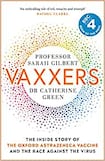
Reading the amazing story of the fast -tracked development of a vaccine against the virus that has upended all our lives in the last 18 months, my first thought is: how did the authors find the time and energy to write this book, even with the help of a ghostwriter?
Dr Sarah Gilbert, professor of vaccinology at Oxford University, and Dr Catherine Green, head of the university’s clinical biomanufacturing facility, tell us the inside story of making the Oxford-AstraZeneca vaccine. The narrative mixes cutting-edge science with their personal story of fighting a pandemic in extraordinary circumstances.
Books describing great scientific advancements tend to be somewhat dry and functional: the authors of Vaxxers come out from behind their benches, explaining the science in terms of their professional struggles and, refreshingly, their quotidian personal lives. It makes for a most accessible read.
Until 2020, new vaccine development took about 10 years. The quickest ever vaccine produced was against mumps – four years from lab to jab. With the death and morbidity toll of Sars-CoV-2, Gilbert, Green and their Oxford colleagues were under pressure to turn a 10-year process into a one-year one.
“There was a concern that if we were doing it too fast, we must be ‘rushing it’: taking less care or missing out important parts of the process,” Gilbert writes. However, “in 2020, there were three key factors that enabled us to to cut out the waiting and crunch ten years into one: first the work we had already done; second, changes to the way funding was given out; and third, doing in parallel things that we would normally do in sequence.”
The key preparatory work that meant they did not need to design, make and test a brand-new vaccine was based on their previous endeavours – developing a flu vaccine and a vaccine against Mers, another coronavirus. The authors had a ready-to-go, tried-and-tested platform technology using a modified adenovirus. It meant they already knew the vaccine design, leaving the immediate focus on identifying the gene coding for the Sars-CoV-2 spike protein, which would then be plugged into the platform.
This “plug and play” approach of a platform technology meant it took just 65 days to make the first batch of Sars-CoV-2 vaccine, an unprecedented achievement.
A seven-month period of testing the new vaccine then began. This was a tense time, checking for safety and efficacy, using volunteers and working closely with drug regulators.
Green says she hit peak stress at the start of May last year. “I was trying to juggle a lot of problems that felt out of my control and like many people I had had no physical contact with another adult in months.” For Gilbert, her previous experience of being a mother of triplets with a full-time job, surviving on a couple of hours’ sleep a night, “stood me in good stead”.
There were unexpected challenges. Despite carefully preparing for press conferences, they were often disappointed with the media portrayal of their message. A completely false social media report that one of the first volunteers in the Oxford vaccine trial had died was an especially low moment. And politicians who use vaccines as a political football get a red card.
A more positive challenge was to acknowledge the genuine fears of those with vaccine hesitancy: “it is natural that people want to understand the risks and benefits of vaccines, and important that as scientists we engage with their concerns”. Addressing vaccine hesitancy runs through the spine of the book.
Even before the trials were complete, it became clear that the Oxford lab did not have the capacity to meet the rising demand for a vaccine. AstraZeneca came on board to provide the critical infrastructure needed to ensure global access to the vaccine. Green likens the adjustment to a family-run pizzeria being taken over by Pizza Express.
In a final chapter they tell us that Disease Y is coming. It is inevitable that a novel virus, threatening a human pandemic, will emerge from the 1.67 million viruses circulating in the world. Pandemic preparedness is vital and must be funded. “We need to make sure that when Disease Y arrives we are better prepared for it than we were [for Sars-CoV-2].”
The book doesn’t deal with the major falling out between the EU and AstraZeneca about vaccine supply. It has little to say about competing vaccines such as those developed by Pfizer and Moderna. It is very much a personal story of one of the most epic moments in human history, perfectly capturing how scientific discovery on this scale is rarely a Eureka moment for a lone genius.
As a grateful recipient of the Oxford-AstraZeneca vaccine, I take my hat off in thanks to these remarkable women.
Dr Muiris Houston is an Irish Times columnist and health analyst












